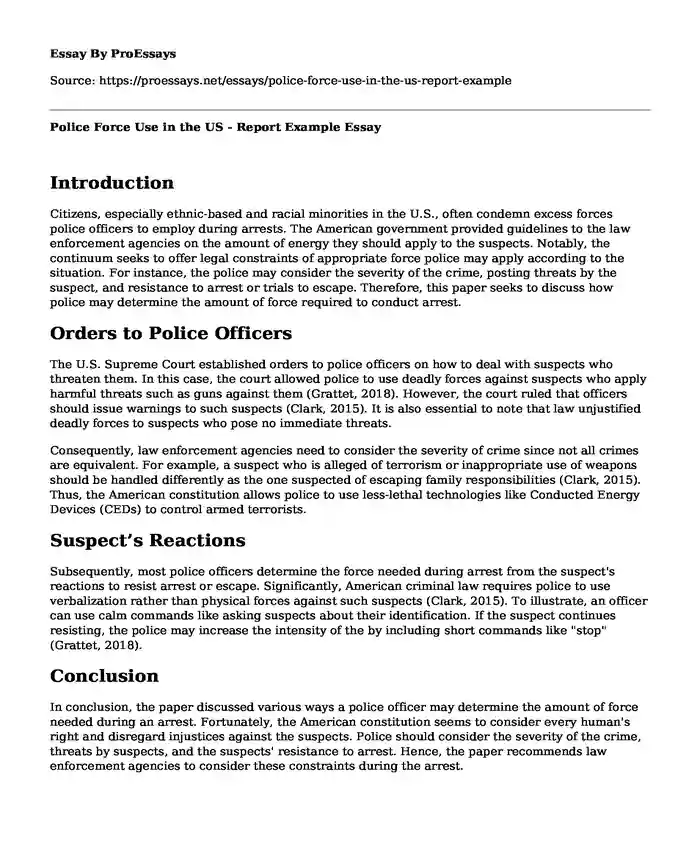Introduction
Citizens, especially ethnic-based and racial minorities in the U.S., often condemn excess forces police officers to employ during arrests. The American government provided guidelines to the law enforcement agencies on the amount of energy they should apply to the suspects. Notably, the continuum seeks to offer legal constraints of appropriate force police may apply according to the situation. For instance, the police may consider the severity of the crime, posting threats by the suspect, and resistance to arrest or trials to escape. Therefore, this paper seeks to discuss how police may determine the amount of force required to conduct arrest.
Orders to Police Officers
The U.S. Supreme Court established orders to police officers on how to deal with suspects who threaten them. In this case, the court allowed police to use deadly forces against suspects who apply harmful threats such as guns against them (Grattet, 2018). However, the court ruled that officers should issue warnings to such suspects (Clark, 2015). It is also essential to note that law unjustified deadly forces to suspects who pose no immediate threats.
Consequently, law enforcement agencies need to consider the severity of crime since not all crimes are equivalent. For example, a suspect who is alleged of terrorism or inappropriate use of weapons should be handled differently as the one suspected of escaping family responsibilities (Clark, 2015). Thus, the American constitution allows police to use less-lethal technologies like Conducted Energy Devices (CEDs) to control armed terrorists.
Suspect’s Reactions
Subsequently, most police officers determine the force needed during arrest from the suspect's reactions to resist arrest or escape. Significantly, American criminal law requires police to use verbalization rather than physical forces against such suspects (Clark, 2015). To illustrate, an officer can use calm commands like asking suspects about their identification. If the suspect continues resisting, the police may increase the intensity of the by including short commands like "stop" (Grattet, 2018).
Conclusion
In conclusion, the paper discussed various ways a police officer may determine the amount of force needed during an arrest. Fortunately, the American constitution seems to consider every human's right and disregard injustices against the suspects. Police should consider the severity of the crime, threats by suspects, and the suspects' resistance to arrest. Hence, the paper recommends law enforcement agencies to consider these constraints during the arrest.
References
Clark, R. (2015). The internationalization of U.S. Criminal Law Enforcement. Criminal Law Forum, 6(1), 115. https://doi.org/10.1007/bf01095722
Grattet, R., & Jenness, V. (2018). Transforming Symbolic Law into Organizational Action: Hate Crime Policy and Law Enforcement Practice. Social Forces, 87(1), 501.
https://doi.org/10.1353/sof.0.0122.
Cite this page
Police Force Use in the US - Report Example. (2023, Nov 25). Retrieved from https://proessays.net/essays/police-force-use-in-the-us-report-example
If you are the original author of this essay and no longer wish to have it published on the ProEssays website, please click below to request its removal:
- Pan Africanism Speech by Kwame Ture - Essay Example
- Sociology Essay Example: Children Being Denied a Fair Chance
- Keegan Case Study Risk Assessment
- Essay Example on Walking On Fire: The Women of Haiti and Their Fight for Justice
- Essay Example on Drug Abuse: The Economic Cost and DEA's Role in Mitigation
- Paper Example on the Rise and Fall of the Border Wall Concept
- Role of Indigenous Canadian Women in the Fur Trade - Free Essay







